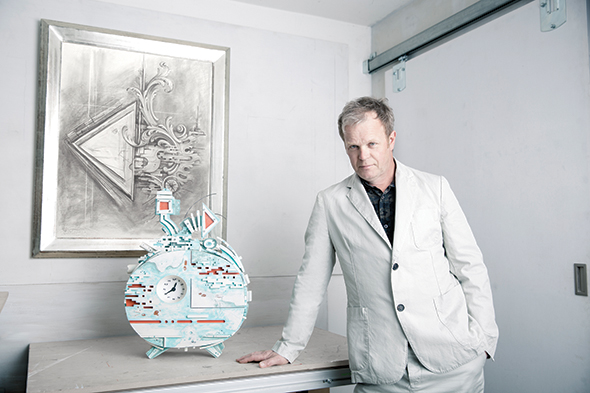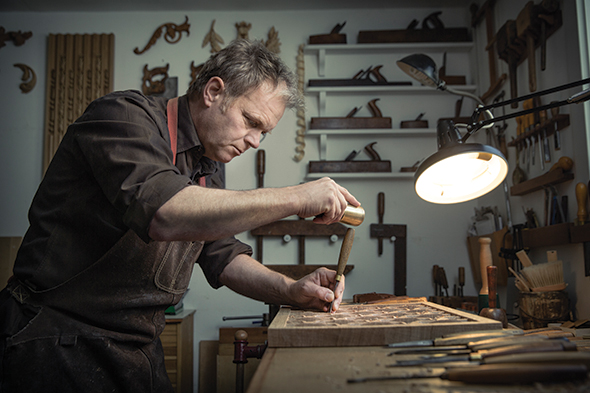
Adam Thorpe is a Master Carver whose ability to create contemporary, original pieces and restore antique masterpieces, garners commissions from galleries and fine art museums alike. His work is currently on display at Velvet da Vinci and The Legion of Honor in San Francisco. Thorpe’s exhibition at Velvet da Vinci, Flowering, is a powerful show that was inspired by roadside memorials. The 25 foot high installation consists of ornately carved flowers (both wilted and in bloom) on a chain link fence. Flowering is a reflection on modern-day culture and is in sharp contrast with Thorpe’s project at the Legion of Honor’s French neoclassical period room, The Salon Doré, which is restorative in nature. In this interview with SOMA Magazine, Mr. Thorpe discusses his experiences working in a wide range of styles and the importance of design.
How did you get your start in woodworking?
I was fascinated by the ornamental woodcarving I saw around me when I was young, growing up in England. Even the simplest village church has carving in it, often very old. When I was about 10, one of the teachers at school read The Carved Cartoon aloud to the class. It is a story about the English seventeenth-century carver Grinling Gibbons, and I was captivated by it. I was also fortunate that my father was a very good woodworker. I was encouraged to use woodworking tools from an early age and he took me to buy my first chisels when I was 13-years-old.
What inspired Flowers, the exhibition at Velvet da Vinci?
I see roadside memorials around where I live, in East Oakland. There was a particular one on a fence right by the on-ramp to the freeway. The flowers would die and it would look uncared for. But occasionally the flowers would be replaced and it would come alive again. I thought it would make a good subject for a piece.
Tell me about your experience restoring the Salon Doré at the Legion of Honor.
I have always admired that room. I remember the first time I saw the Salon Doré over twenty years ago. I felt incredibly fortunate to be able to work on the project. There were some bad repairs from previous restorations, which had to be replaced and large areas of missing carving to recreate. The best part was that I could get close to the work. I saw things that really made an impression on me, technical and stylistic things that maybe only a woodcarver can fully appreciate.
I also worked on a reproduction console table. The museum bought an antique console table of the period, but needed another to make up the pair. There is a lot of carving on the piece, typical Louis XVI style. It was challenging, as the original was complex in design and beautifully carved.
Your work ranges from ornate Grinling Gibbons-esque decor to pieces like Marquetry Boxes that feature graffiti/tag-like writing and skulls. Tell me about your style and what inspires you.
Anything that is wholly traditional in style is effectively a reproduction. I don’t consider that to be my style. I am more interested in designing and making pieces that belong in the world we live in today. I have always been influenced by the traditional, classic styles of ornament, whether it is Gothic, Baroque, or whatever, and I like to reference them in my work. However, I consider imitation to be weak. I have more respect for originality. I get inspiration from my immediate surroundings. I love the textures of the city, graffiti tags, electrical wires, city numbers on electrical boxes, and so on. I see them as ornament in a way. I try to use techniques and skills that I admire from the past to make pieces that look like they were made in 2015, not 1715.

You’ve been a Master Carver for decades. What keeps you excited? What’s new, changing, and interesting in the world of woodcarving?
Designing and making pieces for myself keeps me excited. I enjoy experimenting with new techniques and I have recently been exploring marquetry, which is a very involved and precise inlaying technique.
The most recent change that has affected woodcarving is the use of the computer and digital technology. Now there is the ability to design more efficiently — and often more creatively — using programs like Photoshop. Also, there are CNC machines that are used to shape wood. Although there is a great deal of hideous so-called carving turned out by these machines, I am interested in their potential and am thinking about getting one to see how I can use it.
What advice do you have for young artists (or woodcarvers in particular) who are just getting their start or exploring the field?
I put a lot of emphasis on design. It’s the aspect of carving that interests me most. It doesn’t take too long to learn how to use and sharpen the tools for carving. It takes far longer to understand what makes a good design and how to effectively interpret that design in wood. A beginner can make a very good carving from a strong design. However, no amount of virtuoso technique will save you if the initial concept is weak.
Never lose sight of the fact that you are working in wood. The design and treatment of the work should always reflect that. If you are carving a flower, never forget that it is a woodcarving of a flower, and not a real flower.
Draw a lot, especially from nature.
Text by Talia Page
Photography by Marc Olivier Le Blanc

